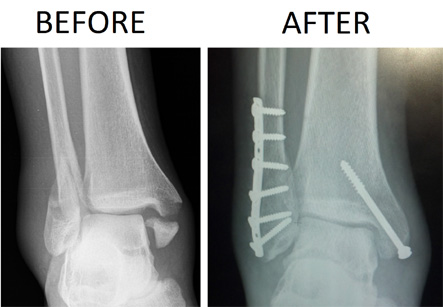Ankle Fracture Surgery
Introduction
Ankle joint is one of the commonly injured and fractured joints. It may lead to pain, inability to walk and swelling. Ankle injury may lead to fracture (broken bone), sprain, dislocation, or tendon injury. Usually an X ray is needed to diagnose the fracture, its location and extent.
The ankle joint is made up of three bones that articulate together, the tibia (shin bone), fibula (thinner bone by the side of the leg), and talus (heel bone). Malleoli are the lumps of bone that one can see and feel on the inside and outside of the ankle. A fibrous membrane called the joint capsule, lined with a smoother layer called the synovium, encases the joint architecture.
The joint capsule contains the synovial fluid produced by the synovium. The synovial fluid allows for smooth movement of the joint surfaces. Additionally, the ankle joint is stabilized by several groups of ligaments which are fibers that hold these bones in place.
The type of ankle fracture depends upon the location of the fracture and which bones of the ankle are fractured. There can be one bone injured, or multiple bones injured. The lateral malleolus fracture is the fracture of the outer part of the ankle and is made up of the fibula bone. The medial malleolus fracture involves the tibia bone. Both malleoli may also be fractured.
Iran ranks among the top 10 countries in orthopedics and Iranian surgeons perform high quality orthopedic surgeries at highly affordable prices

Management
For ankle fracture pain relievers need to be prescribed. To prevent movement the surgeon usually places a splint on the injured ankle for a few days to 2 weeks until the swelling decreases around the joint.
The type of fracture and the stability of the fractured joint will determine the type of splint that will be used, or whether surgery is needed. If the ankle bones are not aligned properly, the doctor may realign them before placing the splint.
There is a risk of serious infections in case of compound fractures and the patient may need antibiotics to prevent such infections.
Sometimes realignment of the bones may need surgery. Ankle fracture surgery will also be needed if any bone has broken through the skin. If the bone breaks through the skin, the fracture is then called a compound fracture. This is more serious than a simple fracture. There is a risk of serious infections in case of compound fractures and the patient may need antibiotics to prevent such infections.
Surgery is usually performed after numbing the leg using regional anesthesia. In some patients the surgery may be performed under spinal or epidural anesthesia wherein whole of the body below waist is numbed.
After the swelling decreases and the patient is reexamined an orthopedic doctor may place a better-fitting cast on the ankle.
Depending on the type of ankle fracture, the patient may be placed in a walking cast, which can bear some weight, or the patient may need a non-weight-bearing cast that will require the use of crutches to assist with walking.